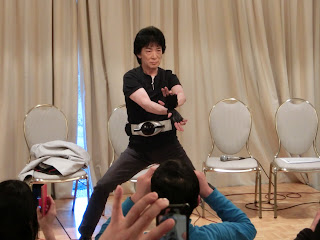 |
| What to Do with the Dead Kaiju? poster outside Toho Cinemas Roppongi. Photo by Brett Homenick. |
What to Do with the Dead Kaiju? opens today in Japan, and I had a chance to check out the first screening at Toho Cinemas Roppongi. Overall, the film is disappointing, but what really makes it a real disappointment is that it had the potential to be much better than it turned out.
For most of the first hour, I was basically enjoying the movie. Unlike most other Japanese films these days (which look like they were shot for TV), this one at least tried to be cinematic. It may not be able to compete with current multimillion-dollar Hollywood tentpoles, but by Japanese standards it was quite impressive for a movie of its type. I suppose I remember all the other "parody" kaiju movies that came out in the years after the release of Godzilla: Final Wars (2004), which were low on budget, quality, and laughs, and essentially expected more of the same here.
 |
| Theater-exclusive goods for What to Do with the Dead Kaiju? Photo by Brett Homenick. |
But I was pleased that such wasn't the case. The direction and cinematography were commendable, the visual effects were enjoyable, and the actors (especially the older ones playing the politicians) did a good job. The major problem here is that the first hour led to the second hour, by which point the movie wears out its welcome. A film like this should tell its story in a brisk 90 minutes. This one drags on for a hair under two hours -- way longer than this movie has any right to be.
What's more, given the premise, you'd think that the film would explore all kinds of fun ways that a military clean-up crew would dispose of dead monsters once they've been neutralized. Not here. Oddly, the kaiju basically looks the same at the start of the movie as it does at the end (which defeats the purpose of making a movie like this), and the various ways the government tries to get rid of the carcass aren't imaginative in the slightest.
Since we never see the monster in action, and since there's only one creature onscreen, the movie lacks the kind of excitement or intrigue that fans of the genre would expect from it. It's sort of like someone watched Shin Godzilla (2016) and thought it would be funny if the focus were on removing the dead body instead. And it's not a bad concept; you just have to do something with it.
 |
| Chibi Godzilla is happy the military is trying to blow someone else up for a change. Photo by Brett Homenick. |
The ending proved that the filmmakers really had no idea what to do with the premise. I won't spoil it, but the resolution comes out of nowhere, and, if you're expecting something creative whatsoever, it'll just make you roll your eyes. In fairness, they do set up (in a way) what happens early on in the film, but the joke -- if you can call it that -- simply doesn't work. It's not funny, and it's the movie's way of telling you that you've just wasted two hours of your time.
There's also a subplot involving mushrooms that I suppose is some kind of tribute to Matango (1963), but, other than giving the film an excuse to make raunchy jokes (um, you'll just have to see the movie to find out), it adds nothing to the story and should have been excised. (Anything bringing the running time down would have been a huge benefit.) I mean, there's even a (monsterless) post-credits gag! Didn't these guys hire an editor?
In short, this one can easily be skipped. But that's not because this was a shabby production -- quite the opposite. It just didn't know what to do with its premise and dragged on for far too long. If you want to see monster action, this one definitely doesn't have any. It's a shame that the script wasted its potential, but I guess we'll have to see whether Shin Ultraman does any better later this year.


























